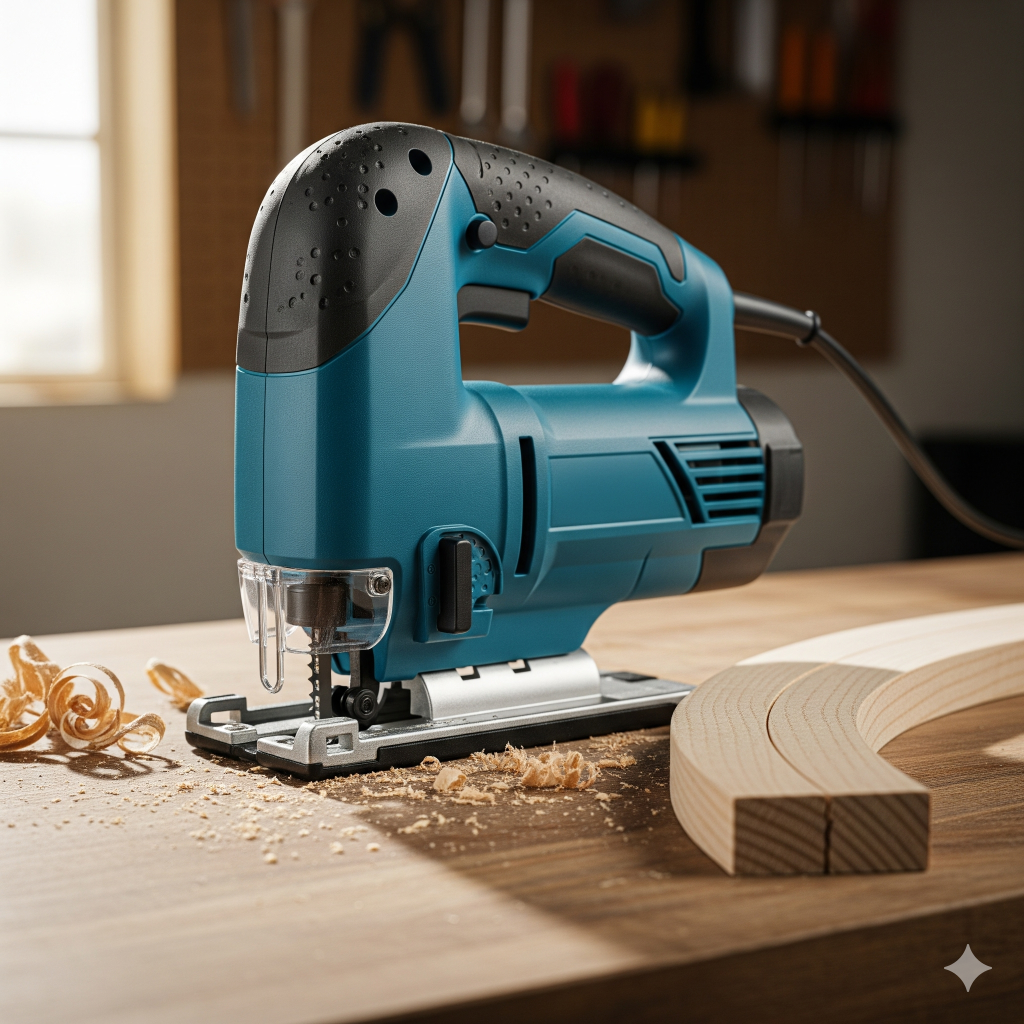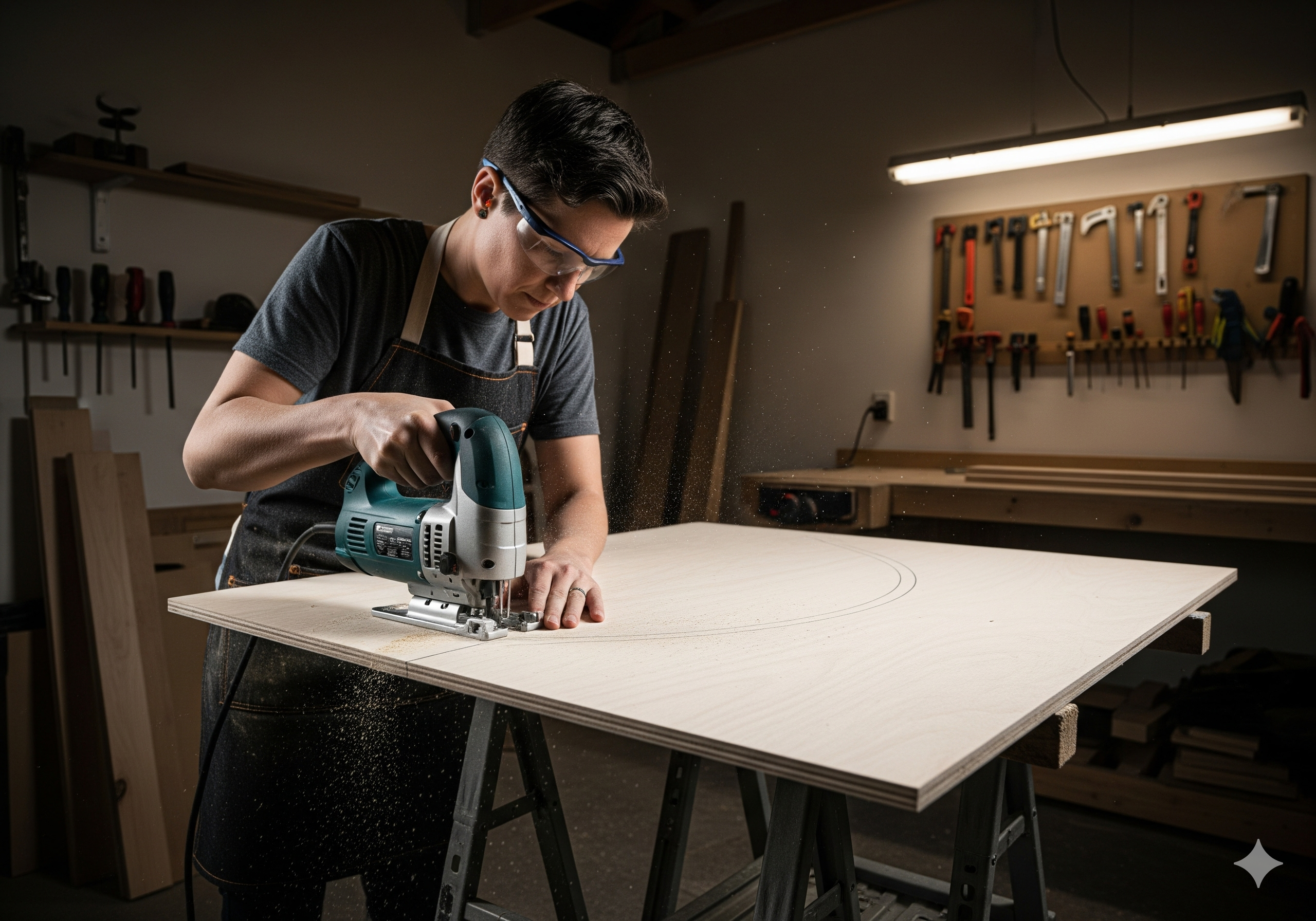Although jigsaws are strong and useful instruments, they may seem a little scary to someone who has never handled one. Knowing how to operate a jigsaw correctly can create a lot of opportunities for your woodworking projects, regardless of your level of experience. We’ll go over all you need to know about utilizing a jigsaw power tool in this article. We can help you with everything from basic setup to cutting suggestions.
What is a Jigsaw Power Tool?
Wood, plastic, metal, and other materials can be sliced straight or curved with a jigsaw, a power tool. Curves and complex patterns are easily handled by the jigsaw, in contrast to a circular saw, which usually only makes straight cuts. In order to cut through materials, the blade rapidly moves up and down.
Although jigsaws vary in size, the most are portable, which makes them simple to use and manage. Additionally, they have movable settings that let you alter the blade’s speed and occasionally even the cut’s angle.
Here’s what you’ll typically find on a jigsaw:
- Blade: The sharp part that makes the cut.
- Baseplate: The flat part that rests against the material being cut, providing stability.
- Trigger: The button that starts the motor.
- Speed control: Many jigsaws allow you to adjust the cutting speed.
- Orbital setting: Some jigsaws have a setting that makes the blade move in a circular motion, which can speed up cuts in some materials.
Setting Up Your Jigsaw
Before you start cutting, it’s important to set up your jigsaw properly. The right setup ensures smoother cuts and better results. Here’s how you do it:
1. Choose the Right Blade
The first step in using a jigsaw is selecting the right blade for your project. Jigsaw blades come in various types, each designed for specific materials. Some blades are best for wood, while others are better for cutting metal or plastic. Make sure to choose the right one based on the material you are working with.
For wood, a fine-toothed blade works best. For metal, a blade with a tougher tooth structure is required. If you’re working with thicker materials, opt for a blade that is designed for heavy-duty cutting.
2. Adjust the Speed
Many jigsaws come with variable speed settings. If you’re cutting through soft wood, a slower speed will work. However, if you need to cut through thicker, tougher materials like metal, a faster speed might be required. The general rule of thumb is to use lower speeds for delicate materials and higher speeds for tougher cuts.
3. Secure the Material
Before you start cutting, make sure the material is firmly held in place. You don’t want the wood or metal shifting while you’re cutting. You can use clamps to secure the material to a workbench or table. This will help ensure accuracy and prevent accidents.
4. Set the Depth of Cut
For some materials, you might need to adjust the depth of the cut. Make sure that the blade isn’t set too deep or too shallow for the thickness of the material. Ideally, the blade should just cut through the material without going too deep into it.
5. Wear Safety Gear
Always wear proper safety gear before operating a jigsaw. This includes safety glasses to protect your eyes, ear protection to guard against the loud noise, and dust masks to avoid inhaling sawdust. Additionally, wear gloves to protect your hands from sharp edges.
How to Use a Jigsaw to Make Cuts
Now that your jigsaw is set up, it’s time to start cutting. Here’s how to use a jigsaw to make straight and curved cuts.
1. Make Straight Cuts
For straight cuts, you will need to ensure that the jigsaw moves along a smooth line. Follow these steps:
- Mark the Cut: Use a pencil or chalk to mark the line where you want to cut.
- Align the Jigsaw: Position the jigsaw so the baseplate is flat against the material, with the blade directly over the line.
- Start the Cut: Press the trigger to start the motor. Move the jigsaw slowly along the line, keeping the baseplate flat against the material.
- Use a Guide: If you want a perfectly straight cut, you can use a guide or straightedge. Clamp the guide to the material and run the jigsaw along it.
2. Make Curved Cuts
Jigsaws are great for making curved cuts. Here’s how you can cut curves with ease:
- Mark the Curve: Draw the curve on the material using a pencil.
- Start at the Edge: Position the jigsaw blade at the edge of the line where you want to start the cut.
- Cut Slowly: Move the jigsaw along the curve, making sure to follow the line as best as you can. Keep a slow and steady hand to prevent the blade from wandering off course.
- Use a Template: If you’re cutting a more complex shape, you can create a template from cardboard or a piece of scrap wood. Attach the template to the material and follow it with the jigsaw.
3. Control the Blade
A key part of using a jigsaw effectively is controlling the blade during the cut. Make sure that you’re cutting in a way that keeps the blade straight and steady. If the jigsaw starts to wander off course, slow down and correct your movement.
Tips and Troubleshooting for Better Results
Using a jigsaw effectively is not just about knowing the basics; there are plenty of tips and tricks to make your cuts even better. Here are some important tips to keep in mind when using your jigsaw:
1. Use the Right Blade for the Job
A jigsaw blade that’s too coarse or too fine for your material can lead to jagged cuts or even breakage. Take the time to choose the best blade for the material you are working with.
2. Cut on the Right Side of the Line
Always cut on the waste side of your line, as the blade may leave a slight edge or residue that can affect the final look of your project.
3. Let the Tool Do the Work
Avoid pressing down too hard on the jigsaw. Let the tool do most of the work. Pressing too hard can cause the blade to bend, break, or make an uneven cut.
4. Prevent Chipping
When cutting wood, you may experience chipping on the underside of the material. To prevent this, place masking tape along your cutting line before cutting. This helps keep the edges clean and reduces splintering.
5. Avoid Overheating
Jigsaws can get hot during use, especially when cutting through tough materials. Take breaks to let the tool cool down, and avoid using it for too long at a time to prevent overheating.
Using a jigsaw power tool may seem difficult at first, but once you get the hang of it, it’s a great addition to your toolkit. Whether you’re cutting wood, plastic, or metal, a jigsaw offers the precision and flexibility to handle many types of cuts. By following these simple steps—choosing the right blade, setting up the tool properly, and using it with care—you’ll be able to take on DIY projects with ease.
FAQs
1. What kind of jigsaw blade should I use for wood?
For wood, choose a fine-toothed blade, such as a high-speed steel (HSS) blade. It will provide smooth cuts without causing splinters.
2. Can I cut metal with a jigsaw?
Yes, jigsaws can cut through metal, but you’ll need a blade specifically designed for metal cutting. Look for bi-metal or carbide-tipped blades.
3. How can I make my jigsaw cuts straighter?
Using a straight edge or guide can help make your cuts more accurate. Always follow the cutting line carefully.
4. Is it safe to use a jigsaw without safety glasses?
No, always wear safety glasses to protect your eyes from flying debris and dust. It’s important to prioritize safety when using any power tool.
5. How do I change the jigsaw blade?
To change the blade, first unplug the jigsaw or remove the battery. Then, release the blade clamp, remove the old blade, and insert the new one. Make sure it’s securely in place before use.


